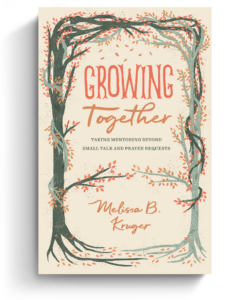When your kids were toddlers, you established a regular family worship routine. Each night before bed, you’d gather your kids in the living room to read a simple Bible story and pray together. You were surprised at how much your preschool kids came to look forward to this evening family time.
Now things have changed. Your older kids don’t want to snuggle on the couch anymore. You’re running from swim meets to cross-country practice. The evening routine has gone out the window. What does family discipleship look like as kids move into the busy elementary and teen years? What do the changes that come with the school-age years mean for your son’s or daughter’s spiritual growth?
Humor, Competition, and Critical Thinking
In order to understand how to pursue discipleship in this new stage, it’s important to know how the kids we’re discipling are growing. Ask a seven-year-old, “What has ears but can’t hear? Corn!” “Why don’t lobsters share? Because they’re shellfish.” “What did the egg say to the frying pan? You crack me up.” When kids begin to laugh at dad jokes like these, it’s a sure sign they’re entering a new stage that’s filled with humor, competition, and critical thinking.
The evening routine has gone out the window. What does family discipleship look like as kids move into the busy elementary and teen years?
By age 7, children can reflect on abstract ideas. They’re also amply verbal and learning new skills in school related to reading, writing, and speaking. Between ages 6 and 10, a child’s interpretive ability increases, and he learns to spell out words, work math problems, and read books.
As kids move toward the teen years, they replace their dolls and action figures with hobbies and sports. Kids in middle childhood develop physically—gaining adult teeth, greater appetites, and improved coordination and strength. They become more active and competitive. The days of pretend play give way to Little League, music lessons, and coding club.
3 Big Shifts
These developmental changes mean parents must make at least three clear shifts in the way we think about family discipleship.
1. Move from parent-directed teaching to self-directed study.
Children as young as 6 or 7 can learn basic Bible reading skills like memorizing the books of the Bible and learning how to look up a Scripture passage. When kids begin to read chapter books, it’s time to put the Bible storybooks away. You can—and should—still read and discuss the Bible as a family, but know that you’re kids are also ready to begin habits of personal Bible reading and study on their own.
Find a reader’s Bible and a kids’ Bible study book that helps your children discover scriptural truths through comparing, contrasting, and analyzing activities. The Kids Read Truth activity books are a great tool to help elementary children develop a Bible reading habit, and books like the Austin Stone Institute’s REAP journal and David Murray’s Exploring the Bible can help kids learn a method for personal Bible study.
At first, you’ll want to assign a section from one of these books, or a week’s worth of devotionals, to your child like homework. Encourage your son or daughter to answer the questions in the book and fill in all the blanks. Then sit down with him or her and talk through the answers. Pray that the Spirit will grow a love for God’s Word in your children and that they’ll use the Bible skills they’re learning throughout their lives.
2. Move from adult influence to peer influence.
Younger elementary kids often perform to gain affirmation from parents and other adults. But during middle childhood, peer influences begin to matter more. School-age children are aware of other people and themselves as members of a group, and they have an increasing desire to be accepted by peers.
At this stage, it’s important for parents to guide their children toward communities that will help them love the Word. This may mean choosing a Christian school or homeschool group where the Bible is studied formally, but it will certainly mean a commitment to the children’s discipleship activities at your local church.
See your local church as a partner in family discipleship, and don’t just sign your kids up for church activities. Get involved. When kids are in preschool, effective family discipleship looks like praying at your child’s bedside. But as kids move toward high school, passing on your faith may also mean you volunteering with the youth group and your leading prayer and Bible study for both your child and their friends.
3. Move from building foundations to shaping hearts.
When kids are young, we’re teaching them the basics of a biblical worldview, and because young children see the world in black and white, they can be rigid in their embrace of the truth. Counselor Julie Lowe observes that kids often enter middle childhood with a rule-oriented mindset and a strong sense of fairness—even pharisaical fairness: “follow the rules and you are good” instead of “Jesus makes us good.” But as kids head toward the teen years, they often begin questioning rules and become more critical of parents, teachers, and one another.
Kids often enter middle childhood with a rule-oriented mindset and a strong sense of fairness—even pharisaical fairness: ‘follow the rules and you are good’ instead of ‘Jesus makes us good.’
While it’s important for us to teach kids God’s law of love, we also want to teach them to use the law rightly. We must help them turn their critical eye on their own hearts so they identify their own sins and the inconsistency that exists between what they say and do. We want to help them turn from sin and cling to Jesus as their Savior.
This will require giving bold correction (even when your child doesn’t receive it well) along with unconditional love and affection. Don’t shrink back from correcting your children when they’re rude or acting selfishly, but do so patiently and gently. You’ll influence their hearts as you demonstrate how Christ’s love (and yours) isn’t tied to their performances. Remember, it’s God’s kindness that draws us to repentance (Rom. 2:4).
Pattern of Growth in Freedom
In his letter to the Galatians, Paul compared Christ’s work of redemption to a son who moves out from under the authority of tutors and guardians into the fullness of his inheritance (Gal. 4:1–7). This is the pattern of growth in freedom.
As Paul Tripp teaches, when kids are young and we’re bigger than them, parents have lots of authority. As our kids grow, we have an opportunity to move from being simply an authority over them to being an influence who walks beside them. This means a mindset change for family discipleship, but with the Spirit’s help, that change in thinking can bear beautiful fruit.
Read more from Jared Kennedy in his book, Keeping Your Children’s Ministry on Mission: Practical Strategies for Discipling the Next Generation (TGC/Crossway, March 2022).
Involved in Women’s Ministry? Add This to Your Discipleship Tool Kit.
 We need one another. Yet we don’t always know how to develop deep relationships to help us grow in the Christian life. Younger believers benefit from the guidance and wisdom of more mature saints as their faith deepens. But too often, potential mentors lack clarity and training on how to engage in discipling those they can influence.
We need one another. Yet we don’t always know how to develop deep relationships to help us grow in the Christian life. Younger believers benefit from the guidance and wisdom of more mature saints as their faith deepens. But too often, potential mentors lack clarity and training on how to engage in discipling those they can influence.
Whether you’re longing to find a spiritual mentor or hoping to serve as a guide for someone else, we have a FREE resource to encourage and equip you. In Growing Together: Taking Mentoring Beyond Small Talk and Prayer Requests, Melissa Kruger, TGC’s vice president of discipleship programming, offers encouraging lessons to guide conversations that promote spiritual growth in both the mentee and mentor.

































